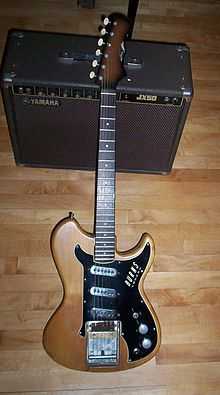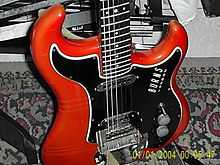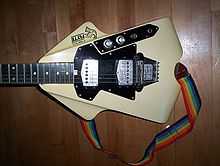Burns London

Burns London is a guitar-making company originally formed in 1960 as Ormston Burns Ltd. It was founded by Alice Louise Farrell(1908-1993) [citation needed] and James Ormston Burns (1925–1998), who has been described as the British Leo Fender.[1] Burns guitars were reintroduced in 1992, and the product line now includes a collector's edition of the first model the company produced.
Burns London
James Burns was often described as the British Leo Fender due to the similarity in terms of his life and the direction his company took under his ownership, and the parallels to be drawn between the latter periods of both companies when they were later sold off. Jim Burns set out to make, in his own words, "mass produced one-offs", such as the Marvin, a radical take on the Stratocaster style with many more differences than it is generally credited with. The Bison was another guitar now considered a classic, combining fewer Fender influences with a shorter scale length of 25", and the now famous "Wild Dog" electronics, allowing the high-output Tri-Sonic pickups to be selected in many different, and sometimes unusual, combinations.


The original guitars made many showbiz friends, and were seen in the hands of some high-profile performers of the time, such as Elvis Presley, Hank Marvin and Jimmy Page.[2] Burns guitars enjoyed a relatively high level of popularity over the course of their first two decades despite often being seen as a cheaper alternative to more expensive US brands such as Fender and Gibson. Copies of the guitars by other manufacturers in Japan, and a Burns guitar was even offered as a prize in a competition organised by Rice Krispies cereal.[3] Another reason accounting for the popularity of Burns in Britain especially was the artificially high cost of American goods due to extreme import tariffs, making it expensive to buy US-made guitars in Britain.
Jim Burns' first commercial foray into electric guitar making came in 1958 when he designed and built the "Ike Isaacs Short Scale Model" for the Supersound Company. His Burns London name and company changed hands several times during the course of the '60s and '70s, all the while retaining the Burns London moniker. The period and name most fondly remembered is, of course, the original Burns London Ltd, established in 1960. The timing of the establishment of Burns London was perfect, with the British guitar market experiencing a huge boom, in part thanks to the popularity of British pop bands like The Shadows, and again thanks to the high tariffs on US-made goods. Even Ampeg, a relatively well-known brand, bought the license to manufacture guitars under the Burns moniker, most probably for the US market, though these were not a commercial success.[4]
The decline
Despite the good times for guitar sales, Burns London Ltd was deeply in debt to suppliers and creditors and in desperate need of rescue. The company and name were sold in 1965 to the Baldwin Piano and Organ Company of Cincinnati for the price of $380,000, small money in comparison to the $13 million paid at the time for Fender (where Baldwin were outbid by CBS).[5] Unfortunately, the acquisition didn't see quality levels increase at Burns, and standards began to slip. The earliest casualties were the pickguards. With huge levels of unsold stock still stored when the Burns name was purchased, Baldwin resorted to cutting out the piece of pickguard bearing the Burns name and replaced it with a much lower quality piece of plastic with the Baldwin name on. This resulted in colour clashes, as the plastic was sometimes slightly the wrong hue, or even shrinkage, while the rest of the pickguard remained in good condition. A little later, Baldwin also resorted to using exactly the same necks for all models, consisting of a bound fingerboard and much lower quality carved scroll headstock. As the quality fell, the earlier popularity declined as well. Baldwin eventually closed the doors on the Burns guitar line in 1970.
Burns Guitars from 1970–1983

While the original Burns guitar line ended in 1970, Jim Burns never quite stopped working on his creations. Several attempts were made to revive the Burns name, in between projects with entirely new companies. In 1966, Jim Burns, unable to use the Burns name, started a new company called Ormston, formed initially to market a range of pedal steel guitars made by Denley. In 1968, just before Ormston shut its doors also, Jim Burns created an original guitar which later became a prototype for the Hayman range, which came about after being hired by the Dallas-Arbiter Organisation to work on a new range of guitars under the name of Hayman. The line lasted from 1969 to 1973, and enjoyed a fair share of popularity.
During the '70s, two more attempts were made at resurrecting the Burns guitar line. Again, due to the agreement with Baldwin, the Burns name could not be used, so the first attempt was named Burns UK, and the second called Jim Burns Actualizers Ltd.
Burns UK

Burns UK appeared in 1974 and lasted until 1977.[5] Burns UK guitars were not made in London, but instead were manufactured close to Newcastle upon Tyne in Jim Burns' native north east. Only one guitar model sold well, The Flyte, which was originally to be named the Conchorde, after the supersonic plane, because of its shape. Its design proved popular among glam rock performers of the time, such as Slade and Marc Bolan.[6] They were also used at the time by Australian band Sherbet, most notably on their "Life... Is For Living" album, where they were acknowledged on the back sleeve liner notes. Despite their unconventional design (which often added to the production cost), the guitars had a rather conventional sound, and again Burns ceased to produce guitars—but not before of few examples of the Burns Mirage, the successor to the Flyte, had been produced.
Jim Burns Actualizers Ltd.
Jim Burns Actualizers Ltd. was established in 1979 and lasted a longer four years, into 1983, and produced some more recognisably "Burns" guitars, such as the Steer, and even the Scorpion.[7] The Burns Steer, a semi-acoustic altered to reduce feedback, was popularized by singer Billy Bragg.
Burns London Ltd.

After Jim Burns Ltd, no more Burns guitars appeared on the market until 1992, when the company was restarted by Barry Gibson who employed Jim Burns as a consultant in the company.[8] The original idea was to manufacture handmade replicas of famous Burns guitars from previous incarnations, such as the Marvin and the Nu-Sonic. The company enjoyed serious critical acclaim from many corners of the market, and manufactured many guitars for individuals, including Steve Howe of Yes and Gaz Coombes of Supergrass. Later on, in 1999, the company began work on a budget line called the Club Series, outsourcing production to Korea. The Club Series became the first Burns guitars ever to be manufactured outside of Britain, but the original Burns design ethics, construction and style didn't suffer as a result, with the range exploding in popularity throughout the following years. The Club Series expanded quickly, with nearly every Jim Burns-designed guitar ever constructed from 1960 to 1983 receiving its own budget model, such as the Marquee which was a budget version of The Marvin, the Steer (most famously played by Billy Bragg, the London Steer being a copy of a Steer guitar built and given to Billy by Jim Burns many years ago), the Bison and even the Barracuda six-string bass/baritone model. Newer designs have begun to emerge in the last few years, usually building upon the designs of the '60s originals, such as the Batwing, a Marquee with a Bison-style headstock. Burns also worked with Queen guitarist Brian May to produced a copy of May's famous Red Special guitar (which uses Burns Tri-Sonic pickups), and this model was awarded "Best Electric Guitar of the Year 2001" by Guitarist magazine.[9]
More recently, an even cheaper range (manufactured in China) has emerged with two new models, the Cobra and the Nu-Sonic. The Cobra is the closest Burns have come to a straight copy in its lifetime. The body is that of a Stratocaster, but the model retains the sectioned pickguard. Tri-Sonic pickups and (shrunken) batwing headstock common to other Burns guitars. Meanwhile, the Nu-Sonic borrows the name of an original Burns guitar, and resembles more the Fender Telecaster, albeit with a distinctly different pickup setup with two Tri-Sonics and a bridge humbucker borrowing directly from the Steer. As well as the pickups, it also retains the shrunken batwing headstock of its cousin, as well as a German carve around the front edge of the guitar.
Notable Burns players
Hank Marvin, Bruce Welch and John Rostill of the Shadows (from 1964–1970, between periods when Fender instruments were used). They were also featured as models with the band's puppets in the Thunderbirds Are Go! film. Also John McNally, Mike Pender and Frank Allen of the Searchers. Mark Bolan also used one as did Edwyn Collins of the Eighties band Orange Juice in earlier years. Peter Møren of Peter, Bjorn, & John. Kim Salmon was known to use a Burns bass during the late-80's period of The Scientists. Australian musician Stu Thomas has been playing a Barracuda baritone guitar, and a Club Series Marquee for many years in Australia and Europe. Ryan Hahn of Local Natives recently began playing an all white Vista Sonic at live shows.
Notes
References
- Day, Paul (1979). The Burns Book. pp Publishing.
- Gjörde, Per (2001). Pearls and Crazy Diamonds. Göteborg, Sweden: Addit Information AB.
External links
| Wikimedia Commons has media related to Burns guitars. |
- Burns London Ltd
- http://www.burnsguitarmuseum.com/
- Burns Guitars Since 1992
- HandCraft Guitars (bought remaining stock of Burns USA parts
- Hayman
- Film of the Burns Guitar Factory in 1965
- The Guitar Collection features various Supersound, Burns Weill, Burns, Hayman and Shergold guitars.